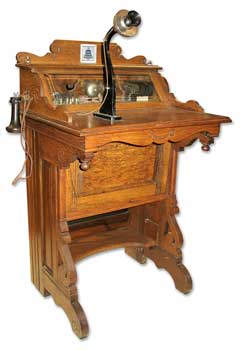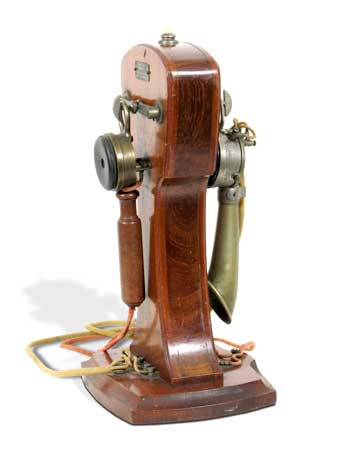| Contact |
| Back | Next | Home |
Early Telephone Apparatus
This page is under construction. Background information on
telephony will be added later.
|
|
 |
| Hughes
Microphone ca. 1900 (French) Unsigned but likely Pericaud or Radiguet In 1878, the carbon microphone was invented by David Edward Hughes. Hughes's microphone was the early model for the various carbon microphones now in use. It relies on the property that the resistance of a carbon rod will vary as it is vibrated by sound. This apparatus was manufactured to be used for physics experiments in schools and universities. |
Blake Transmitter 1883 The Blake transmitter was the first successful telephone transmitter (microphone). It was invented by Francis Blake in 1878 and used a carbon and platinum resistance element. It was later improved by Berliner and remained the standard for many years. |


Bell Liquid Telephone Transmitter and Receiver
Replica of 1876 Invention

Bell "Centennial" Telephone
Replica of 1876 model
Desk Telephones
|
|
|
|
Tapered Shaft Oil-Can Candlestick Stromberg Carlson 1900 Nickel plated, tapered shaft, aka "oil can" desk set. This rare set is known as the oil can because of the way it looks upside down. It is equipped with the ornate, well marked faceplate and the very hard to find "brass bottomed" receiver. Tapered shaft upright desk sets were the second form of "shaped" candlesticks.
Non-dial Candlestick This upright desk telephone was Stromberg Carlson's first straight shaft candlestick telephone.
The Western Electric model 102 was the bell system's first handset telephone. This desk set is equipped with the early seamless "spit-cup" E1 handset.
The Western Electric model 202 was the bell system's second handset telephone. This desk set is equipped with the early seamless "spit-cup" E1 handset.
|
11 digit Potbelly Dial Candlestick Strowger 1905 Potbelly upright desk sets were the first form of candlesticks. This is the first dial telephone. The inventor, Almon Strowger, was an undertaker in Kansas City in the late 1800s. The wife of his only competitor worked the switchboard at the local telephone exchange. Whenever a caller asked to be put through to Strowger, she would instead deliberately put the call through to her husband, his competitor. After spending years complaining to his local telephone company, Strowger found a way to solve this problem by developing the first automated telephone switch out of electromagnets and hat pins. Strowger filed his patent application on March 12, 1889, and it was issued on March 10,1891 as patent No. 447,918. Strowger formed his company 'Strowger Automatic Telephone Exchange' in October 1891. On November 3, 1892, the first Strowger exchange was opened for public service in LaPorte, IN, with about seventy-five subscribers. When his system made its debut, Almon Strowger bragged that his exchanges were "girl-less, cuss-less, out-of-order-less, and wait-less."1
Straight-Shaft Dial Candlestick The first rotary dial upright desk set used by the independent telephone companies.
The
plaque on the telephone reads: This instrument used by Maj. Henry L.
Higginson at Boston, Mass. To open the Transcontinental telephone line
with Thomas A. Watson at San Francisco, Cal. Monday evening January 25,
1915. Transmitter cutout & signal buttons added The transcontinental telephone line linked the Atlantic seaboard with the West Coast (and is often referred to as the New York-San Francisco line). This was the first line to use DeForest's audion--an early vacuum tube. Thus, it is often regarded as a key event in the history of modern electronics.
|
|
|
|

Thompson Houston Desk Telephone |
|
|
|
This model, dubbed the "Shirley Temple" phone by collectors, is the first handset telephone used by the independent telephone companies. |

Cabinet Desk Phone
Western Electric
ca. 1890's
Also referred to as a "Vanity Phone"
Wall Telephones
|
|
|
1 Ron Christianson, http://www.museumphones.com/
| Contact |
| Back | Next | Home |










